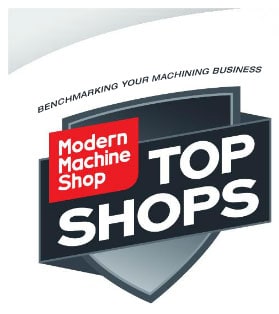 One of the best ways to learn how to make your business more successful is to study the practices of other businesses, especially successful businesses. Being aware of what other businesses do and comparing your business to them goes under a lot of names, but two you'll hear often are Benchmarking and Best Practices.
One of the best ways to learn how to make your business more successful is to study the practices of other businesses, especially successful businesses. Being aware of what other businesses do and comparing your business to them goes under a lot of names, but two you'll hear often are Benchmarking and Best Practices.
MMSOnline's annual Top Shops survey is a fantastic Benchmarking resource for machine shops-one of the best there is.
What makes a Top Shop?
Well, for starters, Top Shops realize a 45% higher average profit margin and a whopping 392% higher growth rate than the average of all shops. If those results sound like something you'd like to duplicate in your own shop, read on!
I've reported on these surveys in the past, and always with an eye towards putting my own data analysis spin on the data so we can glean some insights that are not directly reported by MMSOnline. It's a big survey, so there's room to learn some things that haven't already been reported. This year's Top Shops survey just came out, so I wanted to do the analysis and get it out to you in a timely manner.
What's Different About My Analysis?
There seems to be an error as the text that needs to be rephrased is not provided. Please check and provide the text to continue.
Analysis: It's a signal-to-noise problem...
The real trick is in understanding which things Top Shops do differently that actually matter. It's a signal-to-noise problem, in other words.
What you have to do is come up with an algorithm to separate the signal from all the noise. In this case, what I was interested in understanding is what the majority of Top Shops were doing that the majority of Other Shops don’t. So there were four criteria I used to find things worth checking into:
- If more than half the Top Shops have taken on the practice, that's news. It suggests those things are Top Shop Best Practices.
- At the same time, the likelihood of taking on the practice had to be hugely higher for a Top Shop than an Other Shop. In other words, it had to be something fairly unique that Top Shops were doing that Other Shops were not. I draw that line at 30% more likely for a Top Shop to adopt the practice than the average.
- Conversely, if Top Shops are avoiding something that the others do, that's also worth calling out. And again, I use a 30% statistic to try to call out things that are more statistically significant.
- I also wanted to call out practices that have become so common across all shops that they can't be ignored.
Sounds simple, but the results were interesting and present some different conclusions than MMS gave in their write up, so let’s dig in.
Table Stakes: Pay To Play

Table Stakes: Practices so common across the industry you can't get in the game without them...
Let's start with what I'll call "Table Stakes"-these are practices that are so common across all shops in the survey (more than half reported these) that you need to consider them for your own shop lest you be left at a broad competitive disadvantage in the industry.
Here's the list of Table Stakes:
Most of the industry has the following machining equipment:
- Drilling machines
- Grinding machines (for workpieces)
- Lathes (non-CNC)
- Milling machines (non-CNC)
- Sawing machines
- Turning Centers, horizontal CNC
Not surprising, these are the basics.
FWIW, I did notice that Top Shops are slightly less likely to keep a manual lathe or mill (-6% and -15%, respectively). I have long wondered whether it wouldn't make more sense to have a low-end CNC or toolroom CNC than the venerable Bridgeport in the Toolroom. We can't tell from the survey whether that's what the Top Shops have instead, but it's interesting.
In terms of what the survey calls "Tooling Strategies", the majority of the industry follows these practices:
- Carbide recycling
- Coolant management
- Custom/specialty tooling
- Through-tool coolant delivery
- High-pressure coolant (very close to being over 50% everywhere)
The latter 2 (Through-tool and High-pressure) are not surprising if you've ever looked at how much performance can be gained with Through-tool or Through-spindle coolant. It's something very much worth investing in, and it seems the knowledge of this has now permeated most of the industry. What's interesting is again, how fast it's taking over. Last year, for example, High-pressure coolant was 64% more likely to be used by Top Shops and this year that lead has fallen to 22%.
Workholding had two table stakes entries:
- Indexers/rotary tables
- Multiple workpiece fixturing
For software, everyone has:
- CAD - 3D (not 2D, though)
- CAM
It's worth noting that Toolpath simulation/verification software missed being industry standard by just a few percent. Compared to the prior year, Toolpath Simulation has become a lot more common. Our customers recently helped us quantify the benefits, and we were surprised at how much value they were getting from Toolpath Simulation. It’s no wonder it’s become a must have tool in the shop.
Speaking of CAM, you'd better have High Speed Machining toolpaths, because most of the industry now uses them. The productivity gains there are just too large to ignore.
In terms of the materials most every shop can machine, they are:
- Aluminum
- Brass
- Bronze
- Mild steels
- Stainless steels
- Tool steel
- General plastics
Pretty broad.
Last year, we saw that Top Shops were investing heavily in process improvement. This year, Continuous Improvement has become table stakes-so many do it that you are likely to be at a disadvantage if you don't too.
Sales and Marketing tools, always an interesting area, now include the following for Table Stakes:
- Customer Tours
- Online Company Website
- Sales Personnel
What about Human Resources Table Stakes? The majority of all shops have the following:
- Annual review and raise program
- Bonus plan
- Education reimbursements
- Formal employee training program
- Paid medical benefits
If your shop doesn't offer at least those benefits, they're a below market opportunity.
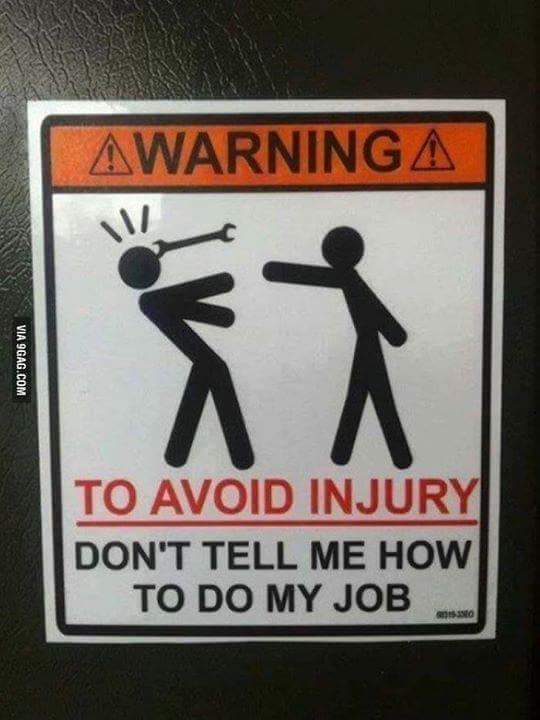
Training: It's Our Job To Tell You How to Do Your Job!
And lastly, the majority of shops invest in training their shopfloor personnel 8-20 hours a year.
None of this is very surprising, except perhaps how quickly some of it has consolidated itself into the industry. But, it's important to be aware of Broad Industry Best Practices.
Now let's dig into what sets the Top Shops apart from the rest of the pack.
Shop Profiles
It's always tempting to think there is some external or structural reason Top Shops have an advantage. The Shop Profile information helps us to see where that's true or not.
In general:
- Top Shops were hugely less likely (-70%) to be captive components of larger companies. Instead, they are independents-either Contract or Job Shops. The difference being that Contract Shops largely do repeating part orders while Job Shops do short run and non-repeating jobs.
- Top Shops are about equally as likely to be Job Shops as the average, but they are more likely (55%) to be Contract Shops. The mix is evenly split between Contract and Job Shops.
- Top Shops make about the same number of differnet parts, with a median of 565 versus 500 different kinds of parts in a year. However, at the edges, the average shop can get dragged into doing a lot of parts (average 5874) while Top Shops stay more focused (average 2097). Beware doing too many different parts is the takeaway.
- Top Shops make more total parts on the Median (133% more), but if we look at averages, there are exceptions at the edges. Top Shops make an average of 1.2 million parts a year while the overall average is 2.2 million. There are some big outliers that are not Top Shops that skew the average way up.
- Batch sizes are small, but the median Top Shop keeps them from being too small. Top Shop median was 48 pieces, which is 60% higher than other shops with a 35 piece median. If we look at the averages, Top Shops are lower at 250 pieces versus 343. Again, we can see there are outliers that skew the averages higher.
Industries

Top Shops are 81% more likely to in the Off-road & construction machinery industry than Other Shops...
Do Top Shops pick more lucrative industries?
Top Shops are more likely to be in the following industries:
- Off-road equipment & construction machinery: 81% more likely for Top Shops
- Appliances: 61% more likely
- Medical: 46% more likely
- Military: 36% more likely
Top Shops are much less likely to be involved with:
- Forming and Fabricating (non-automotive): -47%
- Die/mold: -33%
- Automotive: -27%
You have to wonder whether there isn't something about those markets that makes them too competitive or harder to excel at.
Machining Technology
This is always a favorite category as for many it equates to, "What piece of equipment or tooling can I buy to make my shop more competitive?"
Machining Equipment: Big Ticket Items
By far the biggest difference was Top Shops are 95% more likely to invest in Flexible Manufacturing Systems. That's such a boring name for what is an extremely sexy technology that I had to present a YouTube video explaining what Flexible Manufacturing Systems are:
Very cool, no?
The second biggest difference was investment in Twin-spindle CNC Turning machines-71% more likely for Top Shops. The essence of the Twin-spindle lathe is that it flips the parts automatically to machine both sides, a huge increment in automation.
Number three, and the last obvious investment Top Shops make that ordinary shops don't is Top shops are 41% more likely to have a Honing Machine.
Equally as interesting are the things Top Shops don't get involved in:
- Plasma or Oxy-Fuel CNC Cutting Machines: -85%
- Waterjet machines: -38%
- Laser cutting machines: -32%
Interesting that these are all technologies aimed at cutting flat plate. I assume part of this is that Top Shops don't want to be Fabricators (see above). But not sure if that's all of it. Do they just not do plate work, or do they sub-contract the rough cutting to others that have Waterjets and the like?
Machining Strategies
These are particular techniques for machining, such as High Speed Machining, which we already mentioned has reached industry-wide status. Top Shops are more likely to use the following:
- Five-axis (positioning only): 54% more likely in Top Shops
- Lights-out machining: 53%
- Four-axis (full contouring): 44%
- Five-axis (full contouring): 37%
- Prototyping: 33%
- Hard turning: 30%
Four and Five Axis, along with Lights Out Machining are coming on strong for Top Shops.
Tooling Strategies
Tooling Strategies are techniques and technologies related to tooling:
- On-machine probing for tool breakage/measurement: Top Shops are a whopping 81% more likely to invest in this. 63.4% of them use it versus a 40% industry average. I expect we'll see this become an industry standard before too long.
- Shopfloor tool vending systems: 65%
- Tool Inventory Management: 56%
- Tool Presetting: 33%
Workholding Strategies
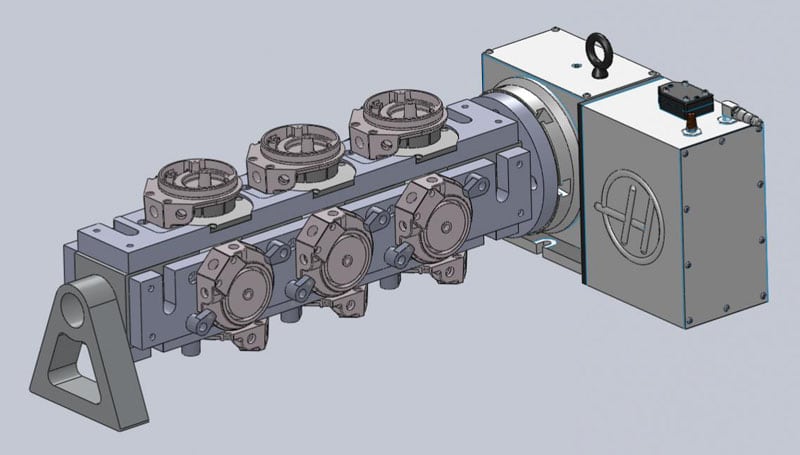
Are Top Shops more likely to use Tombstones on Vertical Mills?
Top Shops are more likely to employ the following Workholding Strategies:
- Quick-change devices: 53%
- Tombstones: 42%
- Vacuum Chucks: 48%
The Tombstone choice is interesting. Given that Top Shops are almost neck and neck with the average shop on Horizontal Machining Center usage, this must imply the difference is they're far more likely to use tombstones on Vertical Machining Centers, presumable with a Fourth Axis.
Software
Top Shops are more likely to use the following software:
- ERP/MRP: 59% more likely
- SPC/quality management software: 32%
- CMM software: 31%
Interestingly, they 31% less likely to use PLM software. Perhaps PLM software is more of a Big Company thing and as we've seen, Top Shops are often smaller, more nimble organizations.
Materials
Top Shops are willing to get involved with materials others won't, but there's also at least one material they don't like to touch.
Top Shops are more likely to machine the following:
- Compacted graphite iron: 187% more likely
- Medical-grade plastics: 78%
- Titanium: 61%
- High-temp alloys: 44%
Interestingly, Top Shops are 85% less likely to machine wood.
The Median number of machines on the Shop Floor is 56% higher for Top Shops: 14 versus 10.
Neither average age nor capacity utilization of machines seemed like a compelling difference for Top Shops
Shopfloor Practices & Performance
This category takes us into the realm of Lean Manufacturing and similar methodologies along with some of the statistics used to measure the impact of such strategies.
Shopfloor Process Methodologies
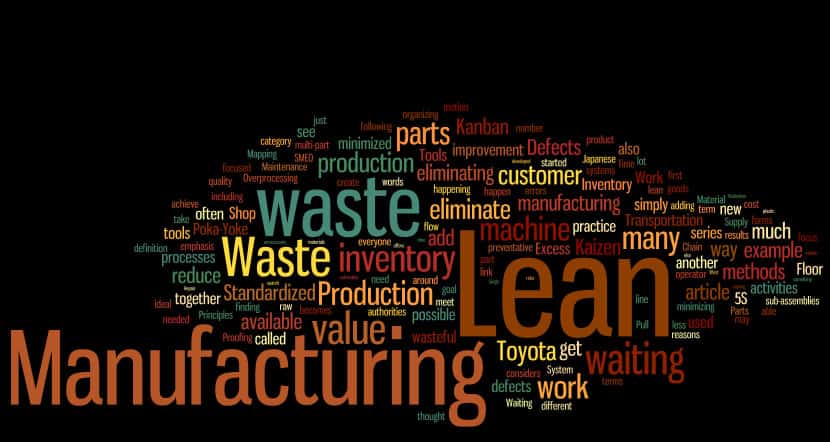
Top Shops are Process and Methodology Junkies!
As we mentioned, the majority of shops claim to have a Continuous Improvement Program, so that's become Table Stakes. Here's what the Top Shops do differently:
- Over 50% of Top Shops have the following:
- 5s Workplace Organization
- Continuous Improvement Program
- Quality Certification (ISO, NADCAP, etc.)
- 30-50% of Top Shops have the following:
- Just-in-time movement of material: 85% more likely at a Top Shop
- Value-stream mapping: 90% more likely
- Benchmarking: 43% more likely
- Poka-yoke (error prevention): 108% more likely
That's 7 strategies in use at fairly large numbers of Top Shops. By comparison, there were only 3 strategies in use by more than 30% of average shops:
- Continous Improvement Program
- Quality certifications
- 5S Workplace Organization
If nothing else, Top Shops are Process and Methodology Junkies!
In addition, we see the following:
- Single-minute exchange of dies (SMED): 174% more likely at a Top Shop
- Agile manufacturing: 170%
- Theory of Constraints: 167%
- Cellular manufacturing: 52%
I've put links to guides we've written on many of these so you can research further if interested. Many our part of our Lean Manufacturing Principles Cookbook.
Order Lead Time, On-Time %, Machining-Time, and More Stats
- Top Shops are like the rest of us-circa 20 day lead time to parts.
- Top Shops spend more of the 20 days machining, 32% more. The median Top Shop spends 33% of the time machining versus 25% for Other Shops. This suggests Top Shops are machining more complex parts.
- Identical 95% median on-time delivery rates for all shops. Top Shops average 98%, however, versus 88.8% for all shops. This suggests some poor performance by the outliers among Other Shops.
- First-pass Quality Yield (% of parts passing inspection first time): Almost the same. Everyone is doing a good job on quality, it seems.
- Scrap and Rework %: The median Top Shops are 60% more likely to get the part right the first time. This suggests their greater organization and investments in improvements have paid off handsomely on scrap rates.
- Machine Usage is 10 hours a day for the Median. The Average Top Shop does better than the Average Other Shop, but not that much better. Everyone is keeping the spindles turning 8-13 hours a day. Does this data suggest most shops are running 2 shifts, or just working longer days?
- Spindle Utilization is again, pretty close: 65% on average and 72% for Top Shops.
Other than much lower scrap and rework, there's not much in these statistics that stands out. Perhaps we need some other KPI's to measure Shopfloor Practices?
No Help From the Bleeding Edge
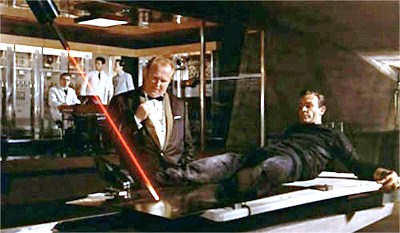
No Mr Bond. 3D Printing cannot save your Machine Shop!
There were 3 fairly sophisticated technologies I thought it interesting that Top Shops were not choosing.
Robots for Part Loading/Unloading
Not only are most shops of all kinds not using robots to load/unload parts, but Top Shops are even less likely (11% less likely). This level of automation is more for particular kinds of high volume parts that are not suitable for Flexible Manufacturing Systems.
The Internet of Things
This was posed as installing a web-enabled, shop-wide machine monitoring system. This one was perhaps not so much rejected as put on hold. The majority of all shops plan to do it, but the most common answer was 2017 or later. Top Shops did show a little propensity for the Second half of 2016, but they also showed some propensity to say they had no plans to install a machine monitoring system.
Additive Manufacturing and 3D Printing
Goodness gracious with all the hype that goes on I surely would've expected to see many great expectations for 3D Printers. Nothing could be further from the truth:
- Across the board, 80+ percent of shops don't have a 3D part printing capability. Top Shops were only 4% more likely to have a capability than Other Shops. That's definitely noise.
- Among those that had 3D Printers, Top Shops largely had Desktop Printers (146% more likely) while Other Shops had bought industrial grade 3D printers. Score one for Top Shops dabbling without investing heavily.
- When we look at what shops were doing with their 3D Printers, the most common use was Look and Feel Prototypes to validate designs. I thought it interesting that the Top Shops who have 3D Printers (and remember, they're likely just desktop models) are using them to create Tooling and Fixturing for internal use (77% more likely than other shops). Yet, Top Shops are very unlikely (54%) to make Short-runs of parts.
Looks like the killer use (if there even is one) for 3D Printing in most shops should be to get a Desktop 3D Printer and use it to make Tooling and Fixturing. That makes sense and is a pretty inexpensive investment to make.
It also suggests we're far from the reality catching up to the hype.
Business Strategy

We're from Madison Ave and we're here to help!
Having the best Shop Floor in the world doesn't help if you can't get the word out (Darn, I wish it wasn't true!)-so let's see how Top Shops approach the Business Side differently.
Let's start with Supply Chain Practices. There are a bunch of things Top Shops do differently, and we'll start with 3 things that more than half of them do:
- Collaborative design with customers (DFM): Customers always appreciate when you help them understand how to make their parts more cheaply. At 68% more likely, this was the second highest thing Top Shops are more likely to do than others and it was also the thing the most Top Shops are doing. It's it time you got into Design For Manufacturing for your customers?
- Just-in-time deliveries to customers: Another way to save your customers money-make your turnaround fast enough they can count on just in time deliveries.
- Customer satisfaction surveys: Because why wouldn't you want to know what they thought of you? At 62% it's the third thing Top Shops are more likely to do.
In addition, here are the additional areas Top Shops are much more likely to take on than average shops:
- Vendor managed or owned inventories for customers: One more way to save your customers money. Top Shops are a whopping 111% more likely to do this.
- Collaborative design with suppliers: The other end of the DFM loop is collaborating with suppliers as well as customers. 59%
- Certification of major suppliers: 54%
- Just-in-time deliveries from suppliers: 53%. Integrate the whole supply chain for best JIT results.
- Vendor managed or owned inventories: 46%
That's some pretty heavy investment in the Supply Chain perspective. What about Sales and Marketing? Do the Top Shops do it differently?
Natch!
- Trade Associations: A wholloping 89% more Top Shops take advantage of these than Other Shops. I would be curious to understand exactly what benefits they see there.
- Social Media: Yup, 58% more likely. We get a lot of value from it here at CNCCookbook. FWIW, the favorites are LinkedIn, Facebook, and Twitter, in that order.
- Customer Tours: 80% of Top Shops use them to market while only 62% of others do. Make your shop a showcase and then show it off!
- Online Advertising: Top Shops are 41% more likely to use it.
That's it, that's what they do differently for Sales and Marketing.
If it doesn't seem like a lot, consider that you don't have to find all that many customers, they just have to be Good Customers!
- The Median Top Shop had about 30 customers just like everyone else. The Average Top Shop did have more, but this reflects outliers with lots of customers that are presumably much larger.
- The Median Tops Shops rely on 18 of the 30 customers for 80% of their business. That's 20% more customers than the average shop, so Top Shops are a little more diversified, or to look at it another way they have 20% more Good Customers.
- Customer Turnover is low for both Top Shops and Other Shops: 99% or better. It's hard to get new customers and it's hard to find a shop you like would be one way to read that.
Quote-to-Book Ratio
Now on to some deeper stuff. For example, The quote to book ratio for the Median Top Shop was 22% better. Top Shops got 61% of the jobs they bid on while others got 50%.
That has literally flip flopped from last year's numbers. When Top Shops were winning fewer jobs, I believed it was due to their cherry picking more profitable jobs and bidding higher. Now it looks like things are perhaps less competitive as the manufacturing market heats up and Top Shops are trying to grab a disproportionate share of the jobs.
This points to the advantage of having a lower cost basis than your competition. When you make parts less, you have a choice of strategies:
- Bid lower to get the same profit as the competition while growing your market share more quickly.
- Bid the same to capture a higher profit margin than the competition.
Either way, you win if you can make parts more cheaply. Always be looking for ways to do that.
Capital Equipment Spending: Top Shops Buy the Best
The Median Top Shops spends 46% more on capital equipment and the Average spends 158% more.
Given that a lot of the Capital Expenditures have to be for CNC Machines (Tooling is more of a consumable), and that the other statistics suggest similar numbers of machines and similar age of machines, the best way to account for these large differences would be to suggest that Top Shops are buying more expensive machines. They're either more expensive brands or they're far more highly optioned.
Tooling Spending: Top Shops Buy the Best, Again
Tooling expenditures were also considerably higher-the Median Top Shop spends 99% more, almost twice as much, as Other Shops. It may be that that the parts they're making have them going through more tooling, but it also seems highly likely they're buying more expensive tooling as well.
What grade of endmills does your shop use? This might be one of those penny wise and pound foolish situations if you're economizing with cheap cutters.
Employee Costs (Wages and Benefits)
Interestingly, wages, in terms of hourly rates for Operators, Setup Personnel, and CAM Programmers are pretty similar between Top Shops and Other Shops. If there's much difference, its that Top Shops will pay a little more (12% for the Median) for CAM Programmers.
That makes sense, because a single CAM Programmer can impact the cost of a lot of jobs.
Material and Components
Material and Component costs are MUCH higher for Top Shops than Other Shops, both in absolute terms and as a percentage. In fact, this category is almost 3x higher than Other Shops. I suspect that has to reflect the type of parts being made requiring more expensive materials and components.
Profit Margin and Growth

As we have already mentioned, Top Shops enjoy higher profits and are growing faster:
- The Median Top Shop has an 88% higher profit margin than Other Shops while the Average has a 45% higher margin. Your Median Top Shop has a 15% Margin while the Average Margin is 18.6%.
- The Median Top Shop grew 12.3% while the Other Shops were flat and saw no growth. On average, Top Shops grew 18.2% while other shops grew 3.2%. The Top Shops are taking most if not all of the new business that's available for growth.
Two gross metrics for profitability are:
- Median Top Shops sales per machine were 67% higher, though the average Top Shop sold 41% less per machine. Hmmm. Some major outliers mess with the averages there!
- Median Top Shops sales per employee were 29% higher than Other Shops, and 39% higher than the Average Shops.
It sounds like some Top Shops are ahead of demand in their machine purchases (accounting for the artificially low Sales Per Machine figure) but that universally they get more from their employees than Other Shops. Looked at another way, they're not hiring ahead of demand.
Human Resources

One of the biggest standouts here is that while Top Shops employ about the same number of people-the Median was about 22 for all shops-many more of those people were directly involved in manufacturing:
- Top Shops: 71%
- Other Shops: 47%
On average, 52% more of the people at Top Shops are involved in manufacturing. No doubt this helps account for why they get 39% more sales per employee-more of their employees are on the Shopfloor or in the CADCAM office helping to make parts and they have less overhead.
Average Age, Years of Experience, and Turnover
The MMS article makes a big deal out of Top Shops hiring younger people and using apprenticeship programs. I didn't find the actual figures supported that too strongly. The difference in Median ages was 1% younger and Average ages it came out to 6% younger. Hard to make a strong case Top Shops hire younger.
OTOH, they are definitely more likely to have an apprenticeship program, but they are running lean operations that pay almost the same. My conclusion is that they may have some apprentices, but not very many. It's more like businesses keeping an intern around than the major apprentice programs of yore.
Turnover is also quite low for both, although slightly higher at Top Shops. My guess is they're more willing to let people go who don't measure up to their standards.
Best Practices
We're in the home stretch and down to just comparing one area: the best practices human resource programs. Here's the results:
- The biggest difference of any of the numbers came from Top Shops being 804% more likely to conduct Team-Building. Only 5% of Other Shops claim to do Team Building while 47% of Top Shops do it. Could be be as simple as organizing softball games and other fun family events to create a community instead of just an impersonal workplace? I'd be curious to know exactly what that's about, but it is an amazing difference.
- The second biggest difference was the Apprenticeship program. I can't see how that's reflected in any other statistics, but 42% of Top Shops have one which makes them 52% more likely than Other Shops.
- Employee ownership options were rare (7.6% of Top Shops), but 46% more likely than Other Shops.
- Bonus plans were not so rare (78.7% of Top Shops, but even so, Top Shops were 41% more likely to have one.
- Leader/supervisor development was 37% more likely to happen at Top Shops. From my professional career, I think this one is very important. Nothing can mess up a workplace more than a bad manager. And so often, the best worker bee gets made the manager, only to discover that being a great worker bee didn't teach them how to be a great manager.
Conclusion

The secret formula to becoming a Top Shop?
As F. Scott Fitzgerald said in The Great Gatsby, "The rich are different than you and me." So it is with Top Shops, who, as we've seen, do a lot of things differently than Other Shops.
But what they're doing makes a lot of sense if you think about it. It's not voodoo secret rocket science that requires a throughly complete knowledge of the arcane. A lot of it is being better organized, caring about creating a more efficient shop, and being dedicated to making the right investments to get there.
I want to give a special thanks and shout out again to Modern Machine Shop who did the hard job of collecting the raw data with their Top Shops survey-absolutely invaluable stuff!
I plan to follow this article up with some additional articles aimed at helping your Shop get to be more like the Top Shops. Sign up for our weekly email newsletter (just scroll down to the form below) to stay posted.
Be the first to know about updates at CNC Cookbook
Join our newsletter to get updates on what's next at CNC Cookbook.